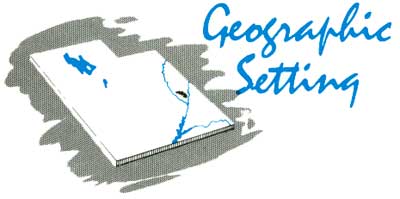
|
Geological Survey Bulletin 1393
The Geologic Story of Arches National Park |
GEOGRAPHIC SETTING

GEOLOGISTS have divided the United States into many provinces, each of which has distinctive geologic and topographic characteristics that set it apart from the others. One of the most intriguing and scenic of these is the Colorado Plateaus province, referred to in this report simply as the Colorado Plateau, or the Plateau (Hunt, C. B., 1956, fig. 1). This province, which covers some 150,000 square miles and is not all plateaus, as we shall see, extends from Rifle, Colo., at the northeast to a little beyond Flagstaff, Ariz., at the southwest, and from Cedar City, Utah, at the west nearly to Albuquerque, N. Mex., at the southeast. Arches National Park occupies part of the Canyon Lands Section, one of the six subdivisions of the Plateau. As the names imply, the Canyon Lands Section of the Plateau comprises a high plateau generally ranging in altitude from 5,000 to 7,000 feet, which has been intricately dissected by literally thousands of canyons.
Arches National Park is drained entirely by the Colorado River, whose deep canyon borders the park on the southeast (fig. 1). Most of the park is drained by Salt Wash, which enters the Colorado River just southeast of The Windows section, but the southwestern part is drained by Courthouse Wash and Moab Canyon, whose flows join the Colorado just west of the bridge on which U.S. Highway 163 crosses the river.
When viewed at a distance of 1 foot, the shaded relief map (fig. 1) shows the general shape of the land surface in and near Arches National Park to the same horizontal scale as it would appear to a person in a spacecraft flying at a height of 250,000 feet, or about 47.5 miles. This map was prepared from part of the reverse side of a plastic-relief map4 at a scale of 1:250,000 by the U.S. Army Map Service of the Moab quadrangle, using a simple time- and money-saving method (Stacy, 1962).
4Plastic-relief maps are no longer available from the U.S. Army Map service but may be obtained from the T. N. Hubbard Scientific Co., Box 105, Northbrook, Ill. 60062. A topographic map at a scale of 1:250,000 of the Moab quadrangle and similar maps at a scale of 1:62,500 for the Thompson, Cisco, Moab, and Castle Valley quadrangles are available from the U.S. Geological Survey, Denver Distribution Section, Federal Center, Denver, Colo. 80225, from the Canyonlands Natural History Association at Moab, and from privately owned shops where maps are sold. Most of the park is covered by the Thompson and Moab quadrangles. The southern part of the park is shown also on the Moab 4 NW, Moab 4 NE, and Mt. Wass 3 NW quadrangles at a scale of 1:24,000. A special topographic map of Arches National Park at a scale of 1:50,000 is in preparation by the U.S. Geological Survey. These maps also may be obtained from the above-listed sources.

| <<< Previous | <<< Contents >>> | Next >>> |
bul/1393/sec4.htm
Last Updated: 8-Jan-2007